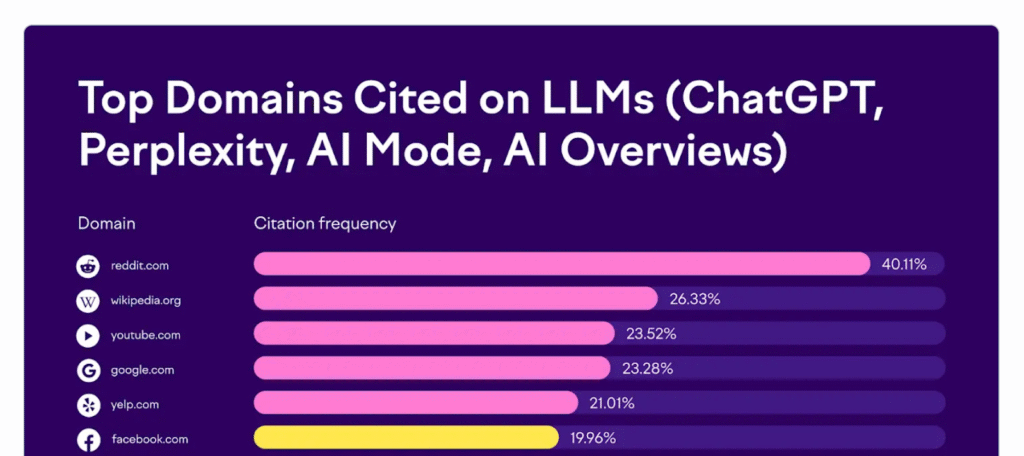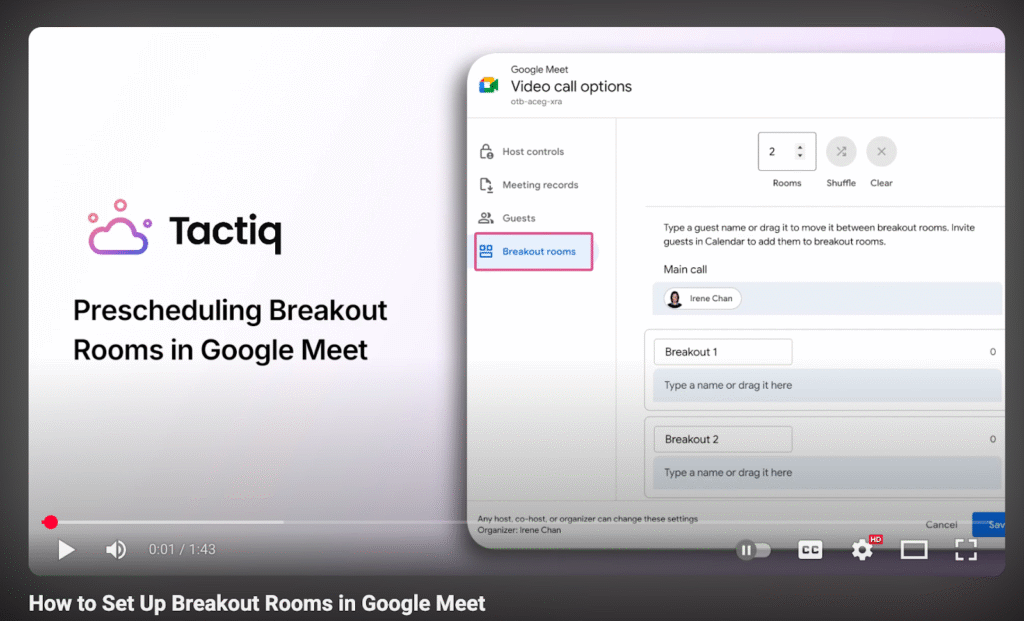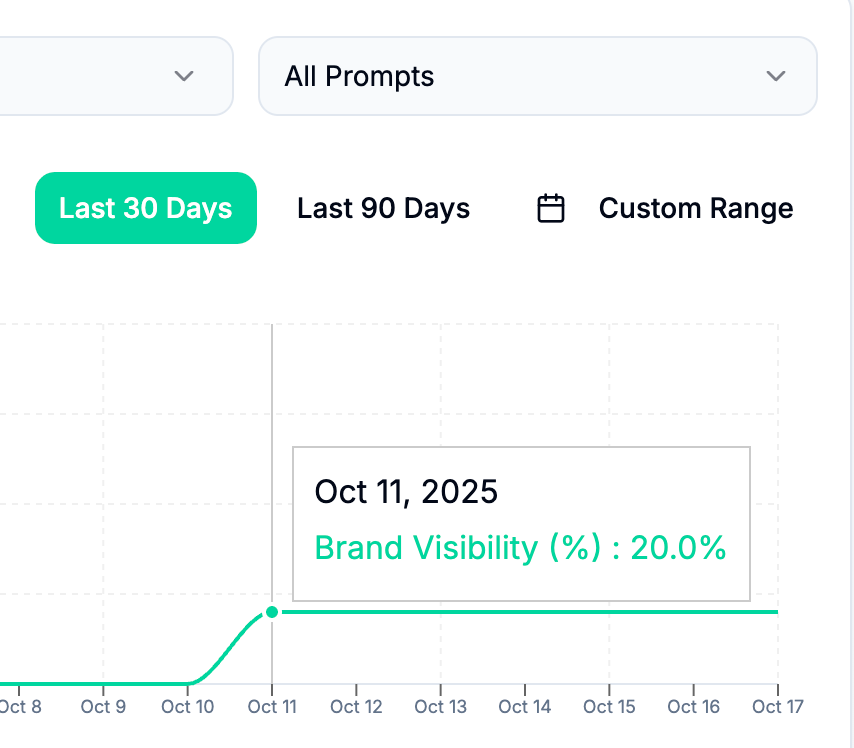Everyone’s talking about AI visibility. LinkedIn experts, podcasts, newsletters—all promising the secret to getting cited by ChatGPT.
But here’s the problem: most advice requires resources you don’t have.
They tell you to create massive content hubs, hire AI optimization consultants, invest in enterprise tools, and completely overhaul your site. Meanwhile, you’re already stretched thin managing SEO, content marketing, and a dozen other priorities.
The truth? You don’t need to do everything at once or have an unlimited budget to improve your AI visibility.
So how do you make sure your brand appears when someone asks an AI tool about your industry, products, or services? There are three strategies:
- Focus on real user questions.
- Make sure your site is crawlable by AI bots.
- Analyze your results and continue to optimize.
Read on to learn the step-by-step guide for each strategy.
Answer the Questions Your Users Are Actually Asking on Reddit
If there’s only one thing you can do, it’s to write an article about a specific question from Reddit. Why Reddit? Because people ask questions there in their natural language, the same way they’d ask an AI tool. And according to data from Semrush, Reddit is the most cited site in ChatGPT.

They’re asking real questions.
Here’s how to find and answer real user questions:
- Search your industry on Reddit: Look for top threads with the most engagement in your niche or product category.
- Identify the real questions: Pay attention to what people are asking, what problems they’re trying to solve, and what specific details matter to them.
- Write a comprehensive article: Create a genuinely helpful guide that addresses every angle of the question, not just a surface-level blog post.
This approach works because AI tools prioritize content that directly answers user questions with depth and clarity. When ChatGPT searches the web for information to cite, it looks for comprehensive sources that thoroughly address the query.
Once the blog post is published, you can then go back to the original thread and answer the question. If the subreddit allows it, you can link to the blog post you just published. And voila! You now have a blog post and a link back to it.
Now, let’s discuss other effective strategies, so you can improve your brand’s AI visibility.
Make Sure Your Tech Is Optimized for AI to Crawl Your Site
While publishing content is critical, it’s not going to be discoverable if you don’t have the right infrastructure in place.
Here’s something most marketers miss: AI tools use specialized bots to crawl websites, and your current robots.txt file might block these bots without you even realizing it.
ChatGPT uses GPTBot. If these bots can’t access your content, you’ll never appear in AI responses, no matter how good your content is.
Check your robots.txt file immediately. Make sure you’re not blocking:
- GPTBot (ChatGPT’s crawler)
- ClaudeBot (Anthropic’s crawler)
- PerplexityBot (Perplexity’s crawler)
- Bingbot (powers Copilot and other AI tools)
Depending on your CMS (Content Management System), you might want to check the settings to make sure that these bots are not blocked. Some of these companies block the robot by default to prevent sites from becoming part of the LLMs’ (Large Language Model) training data.
Beyond crawler access, implement proper schema markup. This structured data helps AI tools understand what your content is about and how to categorize it.
Focus on these schema types:
- Article schema for blog posts and guides
- FAQ schema for question-answer sections
- Organization schema for your company information
- Person schema for author bios and expertise signals
Want a comprehensive checklist? Read our GEO audit guide to ensure your technical foundation is solid.
Publish Content Where AI Grabs Them
AI tools don’t just crawl your website. They pull information from across the web, which means you need to publish content on the platforms where AI systems are most likely to discover and cite it.
Match Your Content Format to the Platform
This strategy requires understanding where your specific content type and audience naturally live online. Based on my personal tests on what gets cited, LLMs tend to have an obsessive-compulsive disorder.
Meaning, they like to be super organized. They categorize similar entities together. If you’re asking about LinkedIn tips, it’s most likely going to grab answers from LinkedIn.
When to publish on LinkedIn
If your topics revolve around professional insights, LinkedIn is your platform. AI tools frequently reference LinkedIn articles when answering business and career-related questions. The platform’s professional context signals expertise and authority.
Publish your thought leadership, industry analysis, and professional advice as LinkedIn articles, not just on your blog. This gives you two chances to be cited: once from your website and once from LinkedIn.
When to publish a video
If your topic is naturally visual or tutorial-based, video is your answer. YouTube transcripts are gold for AI tools because they provide detailed, spoken-language explanations that match how people naturally ask questions.

Create video content for topics like:
- “How to set up…”
- “Step-by-step guide to…”
- “Common mistakes when…”
The combination of video and a searchable transcript makes your content highly discoverable.
When to create content on X
If your audience and industry conversations happen on X (formerly Twitter), you need a consistent presence there. AI tools increasingly reference expert commentary from X when synthesizing industry perspectives and current trends.
Publish thoughtful threads that demonstrate expertise, original takes on industry news, and helpful insights that others reference and share. You can even take advantage of X’s article feature.

For example, I publish crypto marketing tips on X because our potential clients with crypto projects are most likely there. Plus, Grok pulls data from tweets.
The pattern is simple: publish content where your audience already discusses these topics. AI tools learn that authoritative information on your subject lives on those platforms and will prioritize content from there.
Get Links from Top Sites in Your Industry
Links still matter for AI visibility, but not in the same way they matter for traditional SEO.
For SEO, you want links for PageRank and domain authority. For AI visibility, you want links because AI tools use them to understand which sources are authoritative and frequently referenced within your industry.
Think of it as building a web of credibility signals that AI tools recognize when determining which sources to cite.
Target these types of placements:
Industry publications and trade journals
When the leading publications in your space link to your content or mention your brand, AI tools learn you’re a significant player. This is especially powerful for B2B brands where a handful of authoritative industry sites dominate the conversation.
Educational institutions and research organizations
Citations from .edu domains signal that your content is reference-worthy for academic or research purposes. This dramatically boosts your credibility in AI tool assessments.
Government and non-profit resources
These .gov and .org links indicate that your content is trustworthy enough for official resources to reference. For topics related to regulations, health, or civic matters, these citations are particularly valuable.
Popular tools and software directories
If you offer a product or service, being listed and reviewed on authoritative directory sites like Capterra or G2 helps AI tools understand what you do and how you compare to alternatives.
The key difference from traditional link building is that for AI visibility strategies, you care more about how your brand is mentioned in context to the entire article. Traditional SEO, on the other hand, focuses more on the anchor text and the hyperlink.
Analyze Traffic and Results
You can’t improve what you don’t measure. AI visibility requires different metrics than traditional SEO, and you need tools specifically designed to track how you’re performing in AI-generated responses. Traditional analytics tools like Google Analytics won’t show you when someone finds your brand through ChatGPT or when an AI tool cites your content in a response. You need specialized ChatGPT brand tracking like Genrank to understand your AI visibility.

Here’s what to monitor:
- Brand mention frequency. How often does your brand appear in AI responses to industry-related questions? Track this across multiple relevant prompts to understand your baseline visibility.
- Sentiment and context. How is your brand being described? Are you mentioned positively as a leader, or just listed among many options? The context around your mentions affects user perception.
- Competitor comparison. Who else is being mentioned alongside you? Understanding the competitive landscape in AI responses helps you identify gaps and opportunities.
- Prompt diversification. Which types of questions trigger mentions of your brand? This reveals where you have authority and where you need to build more content.
Use a GEO tracking tool to automate this monitoring. The right tool lets you track dozens or hundreds of relevant prompts, see exactly when and how you’re mentioned, and identify trends over time.
Set up regular reporting (weekly or monthly, depending on your resources) to assess:
- Changes in mention frequency
- New prompts where you’re appearing
- Competitor movement in AI visibility
- Content that’s performing well in AI citations
This data should directly inform your content strategy. If you’re consistently mentioned for certain topics but not others, double down on what’s working and create comprehensive content for the gaps.
Your Next Step
You don’t need a complete overhaul to improve your AI visibility. You need focused, consistent action.
Pick one strategy from this list. Maybe it’s checking your robots.txt file today. Or finding one high-engagement Reddit thread and writing a comprehensive answer. Or publishing your next article on LinkedIn instead of just your blog.
Start there. Measure what happens. Then add another strategy.
The brands dominating AI visibility in 2025 aren’t the ones with the biggest budgets. They’re the ones who started early and stayed consistent.
FAQs about AI Visibility
What’s the best tool to track brand mentions in generative AI?
GenRank is currently the leading tool specifically designed for tracking brand mentions in ChatGPT. Unlike general monitoring tools, GenRank focuses exclusively on how your brand appears in ChatGPT, showing you exactly which prompts trigger mentions.
How reliable are real-time brand monitoring features in GEO platforms?
It is generally reliable, as it pulls the data directly from the LLMs. However, note that so many factors can affect how your brand is mentioned in AI responses. Make sure to corroborate with other data sources like Google Analytics and see which LLMs bring you traffic.
How to improve brand mentions in generative AI search engine responses?
Improving brand mentions requires a multi-faceted approach. Create comprehensive, authoritative content that directly answers user questions. And make sure that the technical infrastructure allows AI bots to crawl your site.
